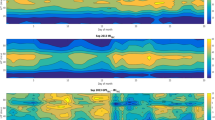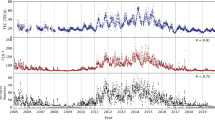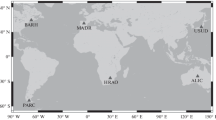Abstract
In the present study inter-comparison of Total Electron Content (TEC) derived from the Global Positioning System, the International Reference Ionosphere (IRI-2016) model and the Thermosphere-Ionosphere-Electrodynamics General Circulation Model (TIE-GCM) during Solar Cycle 24 has been carried out. The short- and long-term variabilities in TEC have been assessed by using spectral, regression and statistical analysis. To ascertain the quiet-time climatology, TEC data have been used after filtering out the solar flares and geomagnetic storms effects. The present analysis exhibits a double-hump structure and clockwise hysteresis in TEC as regards Solar Cycle 24. The solar flux and TEC trend are found to be irregularly and slow during the rise and smooth and quick during the fall period of Solar Cycle 24. Seasonally, the semiannual anomaly is found to be a consistent feature for all phases of the solar cycle, while the winter anomaly seems to be facilitated with a level of solar activity during solstices. Another purpose of the present work is to investigate the performance of IRI-2016 and the TIE-GCM 2.0 models in comparison with GPS-TEC during Solar Cycle 24. Almost perfect agreement is found between observed and modeled TEC, delineating similar trends of the solar cycle, and of semiannual and seasonal variations. Nevertheless, significant biases are apparent between the observed and modeled TEC in terms of local time, seasons and phases of solar activity. Our results show the error in the model estimations in noontime TEC, which is as high as 100% in the IRI model and as low as 60% in the TIE-GCM model. Thus, in general, the IRI model overestimates the noon time TEC values, while TIE-GCM underestimates them.










Similar content being viewed by others
References
Acharya, R., Majumdar, S.: Comparison of observed ionospheric vertical TEC over the sea in Indian region with IRI-2016 model. Adv. Space Res. 63(6), 1892–1904 (2019). https://doi.org/10.1016/j.asr.2018.10.049
Adebiyi, S.J., Adimula, I.A., Oladipo, O.A.: Characterisation of GPS-TEC in the African equatorial and low-latitude region and the regional evaluation of the IRI model. J. Atmos. Terr. Phys. 143–144, 53–70 (2016). https://doi.org/10.1016/j.jastp.2016.03.003
Afraimovich, E.L., Astafyeva, E.I., Oinats, A.V., Yasukevich, Y.V., Zhivetiev, I.V.: Global electron content: a new conception to track solar activity. Ann. Geophys. 26, 335–344 (2008). https://doi.org/10.5194/angeo-26-335-2008
Akala, A.O., Seemala, G.K., Doherty, P.H., Valladares, C.E., Carrano, C.S., Espinoza, J., Oluyo, S.: Comparison of equatorial GPS-TEC observations over an African station and an American station during the minimum and ascending phases of Solar Cycle-24. Ann. Geophys. 31, 2085–2096 (2013). https://doi.org/10.5194/angeo-31-2085-2013
Araujo-Pradere, E.A., Redmon, R., Fedrizzi, M., Viereck, R., Fuller-Rowell, T.J.: Some characteristics of the ionospheric behavior during the Solar Cycle 23–24 minimum. Sol. Phys. 274, 439–456 (2011). https://doi.org/10.1007/s11207-011-9728-3
Atıcı, R.: Comparison of GPS-TEC with modelled values from IRI-2016 and IRI-PLAS over Istanbul, Turkey. Astrophys. Space Sci. 363, 231 (2018). https://doi.org/10.1007/s10509-018-3457-0
Bailey, G.J., Su, Y.Z., Oyama, K.-I.: Yearly variations in the low-latitude topside ionosphere. Ann. Geophys. 18, 789–798 (2000). https://doi.org/10.1007/s00585-000-0789-0
Balan, N., Otsuka, Y., Bailey, G., Fukao, S.: Equinoctial asymmetries in the ionosphere and thermosphere observed by the MU radar. J. Geophys. Res. 103, 9481–9495 (1998). https://doi.org/10.1029/97JA03137
Balan, N., Otsuka, Y., Fukao, S., Abdu, M.A., Bailey, G.J.: Annual variations of the ionosphere: a review based on MU radar observations. Adv. Space Res. 25(1), 153–162 (2000). https://doi.org/10.1016/S0273-1177(99)00913-8
Bilitza, D., Altadill, D., Truhlik, V., Shubin, V., Galkin, I., Reinisch, B., Huang, X.: International reference ionosphere 2016: from ionospheric climate to real-time weather predictions. Space Weather 15(2), 418–429 (2017). https://doi.org/10.1002/2016SW001593
Bohlin, J.D.: Extreme-ultraviolet observations of coronal holes. Sol. Phys. 51, 377–398 (1977)
Burns, A.G., Solomon, S.C., Wang, W., Qian, L., Zhang, Y., Paxton, L.J., Yue, X., Thayer, J.P., Liu, H.L.: Explaining solar cycle effects on composition as it relates to the winter anomaly. J. Geophys. Res. Space Phys. 120, 5890–5898 (2015). https://doi.org/10.1002/2015JA021220
Chaitanya, P.P., Patra, A.K., Balan, N., Rao, S.V.: Ionospheric variations over Indian low latitudes close to the equator and comparison with IRI-2012. Ann. Geophys. 33, 997–1006 (2015). https://doi.org/10.5194/angeo-33-997-2015
Chakraborty, M., Kumar, S., Kumar, B.D., Guha, A.: Latitudinal characteristics of GPS derived ionospheric TEC: a comparative study with IRI 2012 model. Ann. Geophys. 57(5), A0539 (2014). https://doi.org/10.4401/ag-6438
Chapman, S.: The absorption and dissociative or ionizing effect of monochromatic radiation in an atmosphere on a rotating earth. Proc. Phys. Soc. Lond. 43(1), 26–45 (1931). https://doi.org/10.1088/0959-5309/43/1/305
Chen, Y., Liu, L., Wan, W., Yue, X., Su, S.-Y.: Solar activity dependence of the topside ionosphere at low latitudes. J. Geophys. Res. 114, A08306 (2009). https://doi.org/10.1029/2008JA013957
Chen, Y., Liu, L., Wan, W.: Does the F10.7 index correctly describe solar EUV flux during the deep solar minimum of 2007–2009? J. Geophys. Res. 116, A04304 (2011). https://doi.org/10.1029/2010JA016301
Chen, Y., Liu, L., Wan, W., Ren, Z.: Equinoctial asymmetry in solar activity variations of \(N_{m}\)F2 and TEC. Ann. Geophys. 30, 613–622 (2012). https://doi.org/10.5194/angeo-30-613-2012
Cherniak, I., Zakharenkova, I.: Evaluation of the IRI-2016 and NeQuick electron content specification by COSMIC GPS radio occultation, ground-based GPS and Jason-2 joint altimeter/GPS observations. Adv. Space Res. 63(6), 1845–1859 (2019). https://doi.org/10.1016/j.asr.2018.10.036
Coisson, P., Radicella, S.M., Ciralo, L., Leitinger, R.L., Nava, B.: Global validation of IRI TEC for high and medium solar activity conditions. Adv. Space Res. 42, 770–775 (2008). https://doi.org/10.1016/j.asr.2007.09.002
Dashora, N., Suresh, S.: Characterisation of low-latitude TEC during Solar Cycle 23 and 24 using global ionospheric maps (GIMs) over Indian sector. J. Geophys. Res. Space Phys. 120, 5176–5193 (2015). https://doi.org/10.1002/2014JA020559
D’ujanga, F.M., Opio, P., Twinomugisha, F.: Variation of the total electron content with solar activity during the ascending phase of Solar Cycle-24 observed at Makerere University, Kampala. In: Fuller-Rowell, T., Yizengaw, E., Doherty, P.H., Basu, S. (eds.) Ionospheric Space Weather: Longitude and Hemispheric Dependences and Lower Atmosphere Forcing. John Wiley & Sons, Inc., Hoboken (2016). https://doi.org/10.1002/9781118929216.ch12
Duncan, R.A.: The equatorial F-region of the ionosphere. J. Atmos. Terr. Phys. 18, 89–100 (1959). https://doi.org/10.1016/0021-9169(60)90081-7
Elizabeth, P., Manuel, P., Spalla, P., Philip, M., Matt, K.: A review of higher order ionospheric refraction effects on dual frequency GPS. Surv. Geophys. 32, 197–253 (2011). https://doi.org/10.1007/s10712-010-9105-z
Emery, B.A., Coumans, V., Evans, D.S., Germany, G.A., Greer, M.S., Holeman, E., Xu, W.: Seasonal, Kp, solar wind, and solar flux variations in long-term single-pass satellite estimates of electron and ion auroral hemispheric power. J. Geophys. Res. 113, A06311 (2008). https://doi.org/10.1029/2007JA012866
Forbes, J.M., Palo, S., Zhang, X.: Variability of the ionosphere. J. Atmos. Sol.-Terr. Phys. 62, 685–693 (2000)
Galav, P., Dashora, N., Sharma, S., Pandey, R.: Characterization of low latitude GPS-TEC during very low solar activity phase. J. Atmos. Terr. Phys. 72, 1309–1317 (2010). https://doi.org/10.1016/j.jastp.2010.09.017
Garner, T.W., Gaussiran, T.L. II, Brian, T., Robert, H., Calfas, R.S., Gallagher, H.: Total electron content measurements in ionospheric physics. Adv. Space Res. 42, 720–726 (2008). https://doi.org/10.1016/j.asr.2008.02.025
Gonzalez, A.L.C., Gonzalez, W.D., Dutra, S.L.G.: Periodic variation in the geomagnetic activity: a study based on the Ap index. J. Geophys. Res. 98, 9215–9231 (1993). https://doi.org/10.1029/92JA02200
Gopalswamy, N., Sachiko, A., Seiji, Y., Xie, H., Pertti, M., Grzegorz, M.: The Mild Space Weather in Solar Cycle-24 (2015). https://www.researchgate.net/publication/280873177
Gowtam, V.S., Ram, S.T.: Ionospheric winter anomaly and annual anomaly observed from Formosat-3/COSMIC Radio Occultation observations during the ascending phase of Solar Cycle 24. Adv. Space Res. 60(8), 1585–1593 (2017). https://doi.org/10.1016/j.asr.2017.03.017
Hao, Y.Q., Shi, H., Xiao, Z., Zhang, D.H.: Weak ionization of the global ionosphere in Solar Cycle-24. Ann. Geophys. 32, 809–816 (2014). https://doi.org/10.5194/angeo-32-809-2014
Horne, J.H., Baliunas, S.L.: A prescription for period analysis of unevenly sampled time series. Astrophys. J. 302, 757–763 (1986). https://doi.org/10.1086/164037
Huang, Y.-N., Cheng, K.: Solar cycle variations of the equatorial ionospheric anomaly in total electron content in the Asian region. J. Geophys. Res. 101(A11), 24513–24520 (1996). https://doi.org/10.1029/96JA01297
Huttunen, K.E.J., Schwenn, R., Bothmer, V., Koskinen, H.E.J.: Properties and geoeffectiveness of magnetic clouds in the rising, maximum and early declining phases of Solar Cycle 23. Ann. Geophys. 23, 625–641 (2005). https://doi.org/10.5194/angeo-23-625-2005
Jee, G., Lee, H.B., Soloman, S.C.: Global ionospheric total electron contents (TECs) during the last two solar minimum periods. J. Geophys. Res. Space Phys. 119(3), 2090–2100 (2014). https://doi.org/10.1002/2013JA019407
Kane, R.: Are the double-peaks in solar indices during solar maxima of cycle 23 reflected in ionospheric foF2? J. Atmos. Terr. Phys. 68, 877–880 (2006). https://doi.org/10.1016/j.jastp.2006.02.003
Kumar, S.: Performance of IRI-2012 model during a deep solar minimum and a maximum year over global equatorial regions. J. Geophys. Res. Space Phys. 121, 5664–5674 (2016). https://doi.org/10.1002/2015JA022269
Langley, R., Mariangel, F., de Eurico, P., Marcelo, S.: Mapping the low latitude ionosphere with GPS. GPS World 13, 41–46 (2002)
Laštovička, J., Mikhailov, A.V., Ulich, T., Bremer, J., Elias, A.G., Ortiz de Adler, N., Jara, V., Abarca del Rio, R., Foppian, A.J., Ovalle, E., Danilov, A.D.: Long-term trends in foF2: a comparison of various methods. J. Atmos. Terr. Phys. 68(17), 1854–1870 (2006). https://doi.org/10.1016/j.jastp.2006.02.009
Lean, J.L., Meier, R.R., Picone, J.M., Emmert, J.T.: Ionospheric total electron content: global and hemispheric climatology. J. Geophys. Res. 116, A10318 (2011). https://doi.org/10.1029/2011JA016567
Lee, W.K., Kil, H., Kwak, Y.S., Wu, Q., Cho, S., Park, J.U.: The winter anomaly in the middle-latitude F region during the solar minimum period observed by the Constellation Observing System for Meteorology, Ionosphere, and Climate. J. Geophys. Res. 116(A2), A02302 (2011). https://doi.org/10.1029/2010JA015815
Liu, L., He, M., Yue, X., Ning, B., Wan, W.: Ionosphere around equinoxes during low solar activity. J. Geophys. Res. 115, A09307 (2010). https://doi.org/10.1029/2010JA015318
Liu, L., Chen, Y., Le, H., Kurkin, V.I., Polekh, N.M., Lee, C.-C.: The ionosphere under extremely prolonged low solar activity. J. Geophys. Res. 116, A04320 (2011). https://doi.org/10.1029/2010JA016296
Liu, L., Yang, J., Le, H., Chen, Y., Wan, W., Lee, C.-C.: Comparative study of the equatorial ionosphere over Jicamarca during recent two solar minima. J. Geophys. Res. 117, A01315 (2012). https://doi.org/10.1029/2011JA017215
Mannucci, A.J., Wilson, B.D., Edwards, C.D.: A new method for monitoring the Earth’s ionospheric total electron content using the GPS global network, paper presented at ION GPS-93. Inst. of Navigation, 1323–1332 (1993). http://hdl.handle.net/2014/36277
Mayr, H.G., Mahajan, K.K.: Seasonal variation in the F2 region. J. Geophys. Res. 76(4), 1017–1027 (1971). https://doi.org/10.1029/JA076i004p01017
Mazzella, A.J. Jr., Habarulema, J.B., Yizengaw, E.: Determinations of ionosphere and plasmasphere electron content for an African chain of GPS stations. Ann. Geophys. 35(3), 599–612 (2017). https://doi.org/10.5194/angeo-35-599-2017
McIntosh, D.H.: On the annual variation of magnetic disturbance. Philos. Trans. R. Soc. Lond. Ser. A 251, 525–552 (1959)
Mengistu, E., Damtie, B., Moldwin, M.B., Nigussie, M.: Comparison of GPS-TEC measurements with NeQuick2 and IRI model predictions in the low latitude East African region during varying solar activity period (1998 and 2008–2015). Adv. Space Res. 61(6), 1456–1475 (2018). https://doi.org/10.1016/j.asr.2018.01.009
Mikhailov, A.V., Perrone, L.: Comment on “The winter anomaly in the middle-latitude F region during the solar minimum period observed by the Constellation Observing System for Meteorology, Ionosphere, and Climate” by Lee, W.K., Kil, H., Kwak, Y.-S., Wu, Q., Cho, S., and Park, J.U. J. Geophys. Res. Space Phys. 119, 7972–7978 (2014). https://doi.org/10.1002/2014JA020185
Millward, G.H., Rishbeth, H., Fuller-Rowell, T.J., Aylward, A.D., Quegan, S., Moffett, R.J.: Ionospheric F2 layer seasonal and semiannual variations. J. Geophys. Res. 101(A3), 5149–5156 (1996). https://doi.org/10.1029/95JA03343
Moffet, R.J., Hanson, W.B.: Effect of Ionization Transport on the Equatorial F-Region. Nature 206, 705–706 (1965). https://doi.org/10.1038/206705a0
Mursula, K., Zieger, B.: The 13.5 day periodicity in the Sun, solar wind and geomagnetic activity. J. Geophys. Res. 101(A12), 27077–27090 (1996). https://doi.org/10.1029/96JA02470
Oluwadare, S.T., Thai, C.N., Akala, A.O., Heise, S., Alizadeh, M., Schuh, H.: Characterization of GPS-TEC over African equatorial ionization anomaly (EIA) region during 2009–2016. Adv. Space Res. 63(1), 282–301 (2019). https://doi.org/10.1016/j.asr.2018.08.044
Oryema, B., Jurua, E., D’ujanga, F.M., Ssebiyonga, N.: Investigation of TEC variations over the magnetic equatorial and equatorial anomaly regions of the African sector. Adv. Space Res. 56, 1939–1950 (2015). https://doi.org/10.1016/j.asr.2015.05.037
Panda, S.K., Gedam, S.S., Rajaram, G.: Study of ionospheric TEC from GPS observations and comparisons with IRI and SPIM model predictions in the low latitude anomaly Indian sub continental region. Adv. Space Res. 55, 1948–1964 (2014). https://doi.org/10.1016/j.asr.2014.09.00
Perlongo, N.J., Ridley, A.J., Cnossen, I., Wu, C.: A year-long comparison of GPS-TEC and global ionosphere-thermosphere models. J. Geophys. Res. Space Phys. 123, 1410–1428 (2018). https://doi.org/10.1002/2017JA024411
Perna, L., Pezzopane, M.: foF2 vs solar indices for the Rome station: looking for the best general relation which is able to describe the anomalous minimum between cycles 23 and 24. J. Atmos. Sol.-Terr. Phys. 148, 13–21 (2016). https://doi.org/10.1016/j.jastp.2016.08.003
Rama Rao, P.V.S., Gopi Krishna, S., Niranjan, K., Prasad, D.S.V.V.D.: Temporal and spatial variations in TEC using simultaneous measurements from the Indian GPS network of receivers during the low solar activity period of 2004–2005. Ann. Geophys. 24, 3279–3292 (2006)
Rao, S.S., Galav, P., Sharma, S., Pandey, R.: Low-latitude TEC variability studied from magnetically conjugate locations along \(73^{\circ}\) E longitude. J. Atmos. Sol. Terr. Phys. 104, 1–6 (2013). https://doi.org/10.1016/j.jastp.2013.08.007
Rao, S.S., Chakraborty, M., Pandey, R.: Ionospheric variations over Chinese EIA region using foF2 and comparison with IRI-2016 model. Adv. Space Res. 62(1), 84–93 (2018). https://doi.org/10.1016/j.asr.2018.04.009
Rao, S.S., Sharma, S., Pandey, R.: Study of solar flux dependency of the winter anomaly in GPS-TEC. GPS Solut. 23, 4 (2019). https://doi.org/10.1007/s10291-018-0795-x
Richardson, I.G.: Geomagnetic activity during the rising phase of Solar Cycle 24. J. Space Weather Space Clim. 3, A08 (2013). https://doi.org/10.1051/swsc/201303
Rishbeth, H.: Questions of the equatorial F2 layer and thermosphere. J. Atmos. Terr. Phys. 66(17), 1669–1674 (2004). https://doi.org/10.1016/j.jastp.2004.07.008
Rishbeth, H., Mendillo, M.: Patterns of F2-layer variability. J. Atmos. Terr. Phys. 63, 1661–1680 (2001). https://doi.org/10.1016/S1364-6826(01)00036-0
Roble, R.G., Dickinson, R.E., Ridley, E.C.: Seasonal and solar-cycle variations of zonal mean circulation in the thermosphere. J. Geophys. Res. 82, 5493–5504 (1977). https://doi.org/10.1029/JA082i035p05493
Russell, C.T., McPherron, R.L.: Semiannual variation of geomagnetic activity. J. Geophys. Res. 92, 108 (1973). https://doi.org/10.1029/JA078i001p00092
Scargel, J.D.: Studies in astronomical time series analysis. II—Statistical aspects of spectral analysis of unevenly spaced data. Astrophys. J. 263, 835–853 (1982). https://doi.org/10.1086/160554
Scharroo, R., Smith, W.H.F.: A global positioning system based climatology for the total electron content in the ionosphere. J. Geophys. Res. 115, A10318 (2010). https://doi.org/10.1029/2009JA014719
Schunk, R.W., Nagy, A.F.: Ionospheres: Physics, Plasma Physics, and Chemistry. Cambridge University Press, Cambridge (2004). https://trove.nla.gov.au/work/6209073
Selvakumaran, R., Veenadhari, B., Akiyama, S., Pandya, M., Gopalswamy, N., Yashiro, S., Kumar, S., Mäkelä, P., Xie, H.: On the reduced geo-effectiveness of Solar Cycle 24: a moderate storm perspective. J. Geophys. Res. Space Phys. 121, 8188–8202 (2016). https://doi.org/10.1002/2016JA022885
Shi, C., Zhang, T., Wang, C., Wang, Z., Fan, L.: Comparison of IRI-2016 model with IGS VTEC maps during low and high solar activity period. Results Phys. 12, 555–561 (2019). https://doi.org/10.1016/j.rinp.2018.12.022
Shim, S.J., Geonhwa, J., Ludger, S.: Climatology of plasmaspheric total electron content obtained from Jason 1 satellite: climatology of plasmaspheric TEC. J. Geophys. Res. Space Phys. 122(4), 1611 (2017). https://doi.org/10.1002/2016JA023444
Shreedevi, P.R., Choudhary, R.K., Yadav, S., Thampi, S.V., Ajesh, A.: Variation of the TEC at a dip equatorial station, Trivandrum and a mid-latitude station, Hanle during the descending phase of the Solar Cycle 24 (2014–2016). J. Atmos. Terr. Phys. 179, 425–434 (2018). https://doi.org/10.1016/j.jastp.2018.09.010
Solomon, S.C., Qian, L., Burns, A.G.: The anomalous ionosphere between Solar Cycle 23 and 24. J. Geophys. Res. Space Phys. 118, 6524–6535 (2013). https://doi.org/10.1002/jgra.50561
Solomon, S., Burns, A., Emery, B., Foster, B., Liu, H., Lu, G., Maute, A., McInerney, J., Pedatella, N., Qian, L., Richmond, A., Roble, R., Wang, W., Wu, Q.: Thermosphere-Ionosphere-Electrodynamics General Circulation Model (TIE-GCM). In: CEDAR Summer Workshop, Santa Fe, New Mexico (2016). http://www.hao.ucar.edu/modeling/tgcm
Solomon, S., Liying, Q., Anthony, J.M.: Ionospheric Electron Content during Solar Cycle 23. J. Geophys. Res. Space Phys. 123, 5223 (2018). https://doi.org/10.1029/2018JA025464
Tariku, Y.A.: Patterns of GPS-TEC variation over low-latitude regions (African sector) during the deep solar minimum (2008 to 2009) and solar maximum (2012 to 2013) phases. Earth Planets Space 67, 35 (2015). https://doi.org/10.1186/s40623-015-0206-2
Venkatesh, K., Rama Rao, P.V.S., Saranya, P.L., Prasad, D.S.V.V.D., Niranjan, K.: Vertical electron density and topside effective scale height (HT) variations over the Indian equatorial and low latitude stations. Ann. Geophys. 29, 1861–1872 (2011). https://doi.org/10.5194/angeo-29-1861-2011
Verma, V., Joshi, C.G.: On the occurrence rate of high-speed solar wind events. Sol. Phys. 155, 401–404 (1994). https://doi.org/10.1007/BF00680603
Watari, S.: Geomagnetic storms of cycle 24 and their solar sources. Earth Planets Space 69, 70 (2017). https://doi.org/10.1186/s40623-017-0653-z
Yasyukevich, Y.V., Yasyukevich, A.S., Ratovsky, K.G., Klimenko, M.V., Klimenko, V.V., Chirik, N.V.: Winter anomaly in \(N_{m}\)F2 and TEC: when and where it can occur. J. Space Weather Space Clim. 8, A45 (2018). https://doi.org/10.1051/swsc/2018036
Yizengaw, E., Moldwin, M.B., Galvan, D., Iijima, B.A., Komjathy, A., Mannucci, A.J.: Global plasmaspheric TEC and its relative contribution to GPS-TEC. J. Atmos. Sol.-Terr. Phys. 70(11–12), 1541–1548 (2008). https://doi.org/10.1016/j.jastp.2008.04.022
Zhao, B., Wan, W., Liu, L., Mao, T., Ren, Z., Wang, M., Christensen, A.B.: Features of annual and semi-annual variations derived from the global ionospheric maps of the total electron content. Ann. Geophys. 25, 2513–2527 (2007). https://doi.org/10.5194/angeo-25-2513-2007
Zou, L., Rishbeth, H., Müller-Wodarg, I.C.F., Aylward, A.D., Millward, G.H., Fuller-Rowell, T.J., Idenden, D.W., Moffett, R.J.: Annual and semiannual variations in the ionospheric F2-layer: I. Modelling. Ann. Geophys. 18, 927–944 (2000). https://doi.org/10.1007/s00585-000-0927-8
Acknowledgements
This work is sponsored by UGC-New Delhi under Dr. DS Kothari Postdoctoral Fellowship scheme awarded to author SS Rao vide sanction No. 4-2/2006(BSR)/ES/17-18/0048. The work is partially supported by ISRO, Bangalore, under ISRO-SSPS program. The authors are thankful to the Community Coordinated Modeling Center, NASA for providing TIE-GCM and IRI data. Authors are thankful to Dr. Shim, Ja Soon (in-house scientist) and Anne Michelle Mendoza (Runs-On-Request Coordinator) from CCMC, NASA for considering our special request to run TIE-GCM model and timely providing model runs. The authors also thankful to the Space Physics Data Facility (SPDF) OmniWeb for solar flux data and the World Wide Data center (WDC) for the Ap index data. The authors are thankful to Professor R.P. Singh, Department of Physics, BHU, Varanasi, India, for suggestions.
Author information
Authors and Affiliations
Corresponding author
Additional information
Publisher’s Note
Springer Nature remains neutral with regard to jurisdictional claims in published maps and institutional affiliations.
Rights and permissions
About this article
Cite this article
Rao, S.S., Chakraborty, M., Kumar, S. et al. Low-latitude ionospheric response from GPS, IRI and TIE-GCM TEC to Solar Cycle 24. Astrophys Space Sci 364, 216 (2019). https://doi.org/10.1007/s10509-019-3701-2
Received:
Accepted:
Published:
DOI: https://doi.org/10.1007/s10509-019-3701-2




